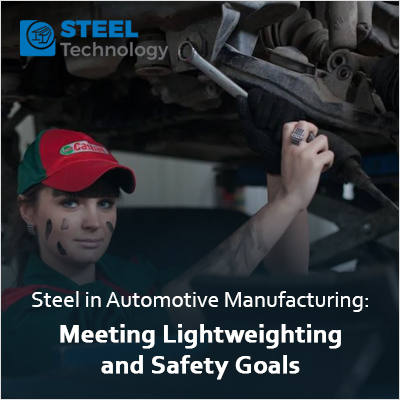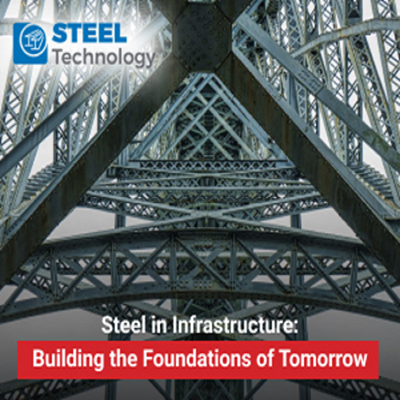Steel in Automotive Manufacturing: Meeting Lightweighting and Safety Goals

Steel has been a foundational material in the automotive industry for decades, owing to its exceptional strength, durability, and versatility. As the industry has evolved, manufacturers have faced the dual challenge of meeting lightweighting goals for improved fuel efficiency and reducing emissions, while simultaneously ensuring the highest standards of safety. This has led to a paradigm shift in the use of steel in automotive manufacturing, with a focus on advanced high-strength steel (AHSS) and innovative manufacturing techniques. In this comprehensive exploration, we delve into the pivotal role that steel plays in achieving lightweighting and safety goals in the automotive sector.
1. Introduction: The Evolution of Steel in Automotive Manufacturing
The automotive industry has witnessed a remarkable evolution in its use of steel as a primary material for manufacturing. Over the decades, steel has transitioned from traditional mild steels to advanced high-strength steels (AHSS), marking a significant shift in the approach to vehicle design and production. This evolution has been driven by the industry's response to multifaceted challenges, including the imperative to enhance fuel efficiency, reduce emissions, and simultaneously ensure uncompromised safety standards.
Historically, mild steels were the go-to choice for automotive manufacturing due to their affordability and ease of processing. However, the demand for improved fuel efficiency and stricter safety regulations prompted a reevaluation of materials. This led to the emergence of advanced high-strength steels, characterized by their exceptional strength-to-weight ratio. The evolution of steel in automotive manufacturing is not merely a story of material substitution but a strategic adaptation to meet the ever-growing demands of a changing
automotive landscape.
In the face of environmental challenges, regulatory demands, and a growing consumer focus on sustainability within the automotive industry, steel has emerged as a versatile and essential solution. The following sections will explore the crucial role that steel plays in tackling the dual challenges of enhancing vehicle lightness and ensuring safety. We will highlight the innovations and advancements that have positioned steel as a leading material in the automotive sector.
2. Lightweighting Imperative in Automotive Design
In the dynamic landscape of automotive design, the quest for improved fuel efficiency and reduced environmental impact has propelled the industry toward embracing lightweight materials. This imperative arises from the understanding that a lighter vehicle requires less energy to propel, contributing to enhanced fuel efficiency and a decrease in overall emissions. Among the myriad materials vying for consideration in the pursuit of lightweighting, steel stands out as a formidable contender, offering a unique combination of cost-effectiveness and inherent strength.
2.1 Lightweighting Strategies
Automakers, under pressure to meet stringent fuel efficiency standards and consumer demands for environmentally conscious vehicles, have explored a variety of lightweighting strategies. Alternative materials such as aluminum, composites, and magnesium have garnered attention for their weight-saving properties. However, steel remains a leading choice, primarily due to its cost-effectiveness and unparalleled strength. Steel's ability to strike a balance between weight reduction and structural integrity makes it a preferred material in achieving the dual goals of lightweighting and safety.
2.2 Advanced High-Strength Steels (AHSS)
Within the realm of steel, Advanced High-Strength Steels (AHSS) have emerged as a transformative force in lightweighting strategies. These steels represent a technological leap forward, offering a unique blend of high strength and low weight. Unlike traditional mild steels, AHSS enables the development of lighter vehicle structures without compromising safety standards. The key advantage lies in the diverse range of AHSS grades, each tailored for specific applications within the vehicle.
AHSS encompasses a spectrum of steel grades, including Dual-Phase (DP), Transformation-Induced Plasticity (TRIP), and Martensitic steels. Each grade possesses distinct mechanical properties, allowing automakers to strategically deploy them in different parts of the vehicle. This versatility empowers engineers to optimize weight reduction in critical areas while maintaining or even enhancing overall safety and performance.
In the face of environmental challenges, regulatory demands, and a growing consumer focus on sustainability within the automotive industry, steel has emerged as a versatile and essential solution. The following sections will explore the crucial role that steel plays in tackling the dual challenges of enhancing vehicle lightness and ensuring safety. We will highlight the innovations and advancements that have positioned steel as a leading material in the automotive sector.
3. Safety Enhancement through Advanced Steels
Safety stands as a paramount concern in the automotive industry, and the role of advanced steels, particularly Advanced High-Strength Steels (AHSS), in enhancing the safety profile of vehicles cannot be overstated. This section delves into the multifaceted ways in which advanced steels contribute to safety, ranging from crashworthiness to innovative manufacturing processes.
3.1 Crashworthiness
Crashworthiness, which refers to a vehicle's capacity to safeguard its occupants in the event of a collision, stands as a fundamental pillar of automotive safety. Advanced steels play a crucial role in enhancing this aspect by efficiently absorbing and dispersing impact energy. The intrinsic strength of these steels allows for controlled deformation during a crash, effectively absorbing the generated forces and preventing intrusion into the passenger compartment. This not only reduces the potential for occupant injuries but also maintains the overall structural integrity of the vehicle.
3.2 Hot-Stamped Components
Hot stamping, a specialized manufacturing process predominantly employed for Advanced High-Strength Steels, represents a revolutionary advancement in the production of safety-critical components. This process involves heating a blank of steel to a high temperature, then forming and quenching it in a die to create ultra-high-strength components with intricate shapes. These components, including pillars and side impact beams, contribute significantly to the vehicle's overall structural integrity. The use of hot-stamped components ensures that these critical parts maintain their structural integrity even under extreme impact conditions, thereby enhancing the vehicle's performance in crash scenarios.
3.3 Tailored Blanks and Laser Welding
Innovations such as tailored blanks and laser welding underscore the industry's commitment to precise control over material distribution, further optimizing safety features. Tailored blanks, consisting of sheets with varying thickness, allow manufacturers to strategically reinforce specific areas of the vehicle based on anticipated stress points during a collision. Laser welding, on the other hand, enables the seamless joining of different steel components with precision, ensuring that the strength is concentrated where it is needed most. This meticulous control over material properties and distribution contributes to the overall structural performance of the vehicle, augmenting safety measures.
In conclusion, the integration of advanced steels in automotive manufacturing serves as a linchpin in fortifying vehicles against the rigors of real-world collisions. The combination of crashworthiness enhancements and innovative manufacturing processes showcases how advanced steels, particularly AHSS, contribute to the industry's unyielding commitment to ensuring the safety of occupants and reinforcing the structural integrity of modern vehicles. The subsequent sections will explore the ongoing challenges and future prospects of steel in the automotive landscape, as well as highlight specific case studies illustrating successful implementations of steel innovations by leading manufacturers.
4. Challenges and Future Prospects
While steel has undeniably demonstrated its prowess in addressing the dual challenges of lightweighting and safety in automotive manufacturing, the industry is not without its ongoing challenges. Striking the delicate equilibrium between weight reduction and cost remains a persistent hurdle. While steel is cost-effective and provides an excellent strength-to-weight ratio, continuous innovations are required to optimize its use in vehicles without compromising economic feasibility.
The pursuit of even stronger and lighter materials represents another frontier for the automotive industry. Research and development efforts are underway to discover and implement novel alloys and manufacturing techniques that can push the boundaries of material strength while simultaneously reducing weight. This relentless quest is driven by the industry's commitment to meeting increasingly stringent regulatory standards and consumer expectations for more sustainable and efficient vehicles.
The future holds promise with the integration of smart materials and advanced manufacturing technologies. Smart materials, capable of adapting to changing conditions, and manufacturing processes leveraging artificial intelligence and automation, offer avenues for further advancements. These technologies can enhance precision, efficiency, and customization in the production of vehicles, contributing to the ongoing evolution of steel's role in achieving the dual goals of lightweighting and safety. As the automotive industry continues to innovate, the challenges posed by cost considerations and material strength will likely be met with creative solutions, ensuring that steel remains a cornerstone in shaping the future of automotive manufacturing.
6. Conclusion: The Enduring Significance of Steel in Automotive Manufacturing
In conclusion, steel stands as an unwavering cornerstone in the landscape of automotive manufacturing, intricately woven into the fabric of vehicle design and production. Its enduring significance lies in the pivotal role it plays, skillfully balancing the twin imperatives of lightweight and safety.
The industry's steadfast commitment to innovation has propelled steel technologies to new heights, with advanced high-strength steel (AHSS) leading the charge. This material evolution has empowered automotive manufacturers to craft vehicles that are not only lighter, enhancing fuel efficiency, but also fortified with unparalleled safety features.
As the automotive sector navigates a landscape shaped by ever-evolving consumer expectations, stringent regulatory standards, and a growing focus on environmental sustainability, steel remains a linchpin. The synergy between steel and automotive manufacturing epitomizes a harmonious blend of strength, safety, and sustainability. This partnership not only propels the industry forward but also envisions a future where vehicles are not just more efficient but safer than ever before.
In essence, the enduring significance of steel in automotive manufacturing is a testament to its adaptability, resilience, and indispensable contribution to shaping a future where vehicles seamlessly integrate performance, safety, and environmental responsibility.











